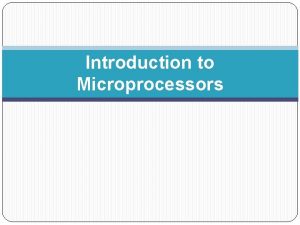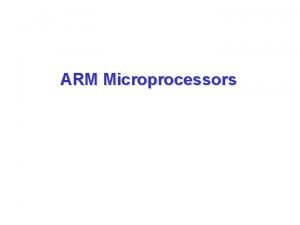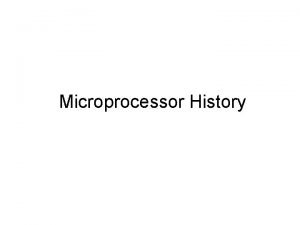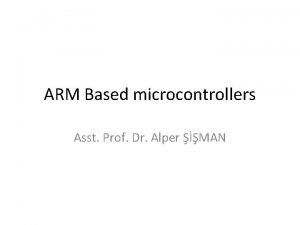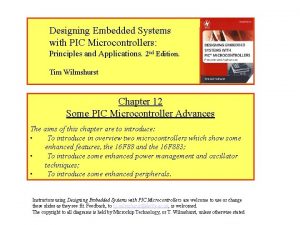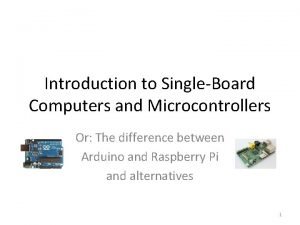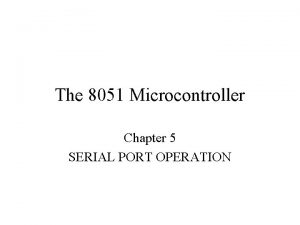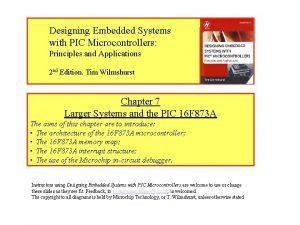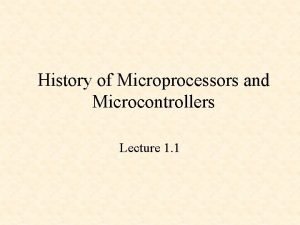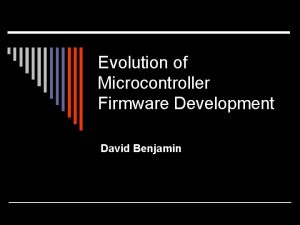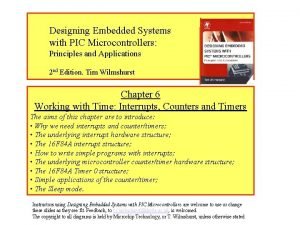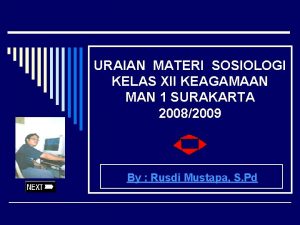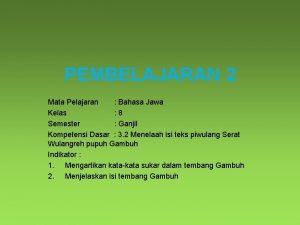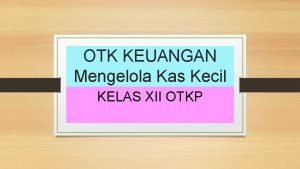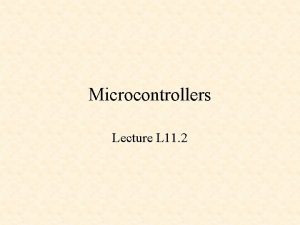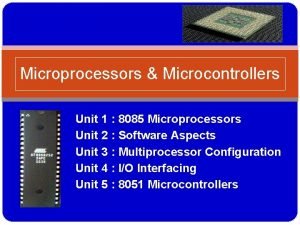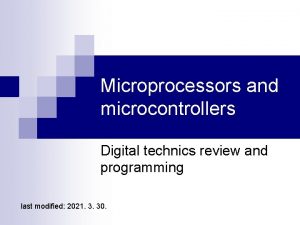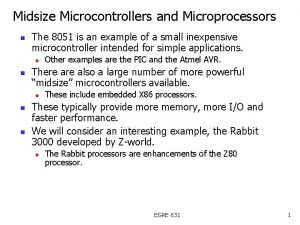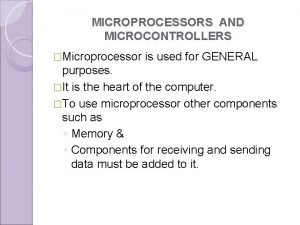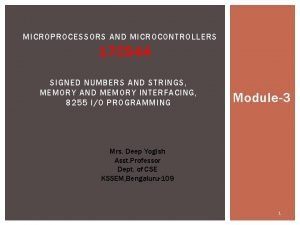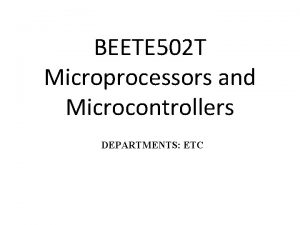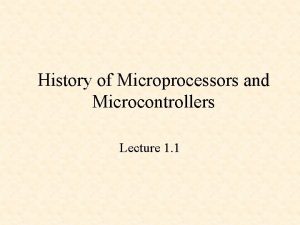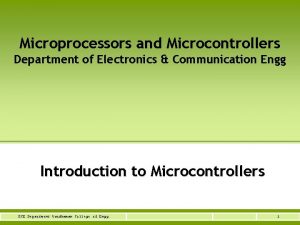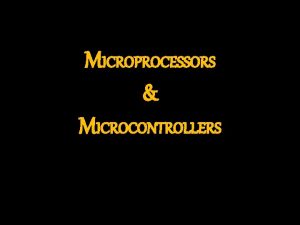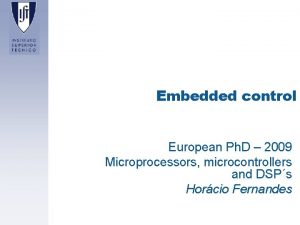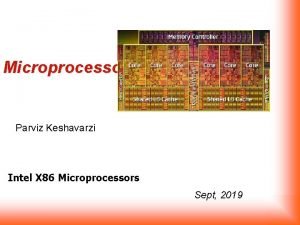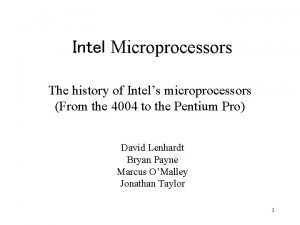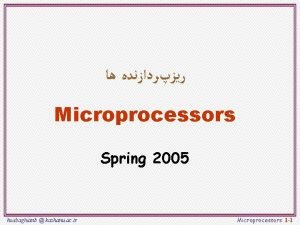Microprocessors And Microcontrollers Semester 4 th 5 th


































- Slides: 34

Microprocessors And Microcontrollers Semester : 4 th , 5 th (TL, ES) Course Code : ES 256 , ES 313 By: Dr. Attiya Baqai Assistant Professor, Department of Electronics, MUET.

IO memory (SFR) ◉ Dedicated to Specific Functions ◉ All AVRs have at least 64, 8 bit I/O locations. ◉ 64 byte section is called Standard I/O memory. ◉ AVRs of more than 32 IO pins (ATmega 64, ATmega 128, ATmega 256) have extended I/O for controlling extra ports and extra peripherals

Data Memory with Extended I/O

SRAM vs EEPROM ◉ SRAM is 8 bit RAM ◉ SRAM also called scratch pad RAM ◉ EEPROM does not lose data while SRAM does when power is off. ◉EEPROM is used when data is rarely changed like settings, options etc. ◉SRAM is used when data or parameters are frequently changed. ◉Data Memory= GPRs+ SFR(I/O Reg)+ SRAM

Data Memory size

AVR Assembly instructions ◉ Arithmetic and logic ◉Branch, jump ◉Data movement ◉Bit manipulation, bit test

AVR Assembly instructions Arithmetic and logic a+b ADD a-b SUB a&b AND Move Bit op. , others reg 1=reg 2 MOV reg=17 LDI a<<1 LSL reg=mem LDS a>>1 LSR, reg=*mem LD mem=reg STS ROL, ROR *mem=reg ST ØC (not avail. In C) Status bits SEI, CLZ. . . No op. NOP a|b OR a++ INC periperal IN a-- DEC peripheral OUT -a NEG heap PUSH a=0 CLR heap POP

AVR Data Movement Instructions ◉ LDI Rd, K ◉ LDS Rd, K ◉ STS Rr, K where 16<=d<=31 where 0<=d<=31 where $0000<=k<=$FFFF You can not copy (store) an immediate value directly into SRAM, this must be done through GPRs. ◉ IN Rd, A ◉OUT A, Rd ◉ MOV Rd, Rr where 0<=d<=31, 0<=A<=64

LDI Instruction Format ◉

Instruction size

Instruction size

Data Format Representation ◉ Hex----- 0 x 0 F, $0 F ◉ Binary----0 b 00001111 ◉ Decimal-------15 ◉ ASCII----- ‘ 2’

Assembly Language Program

Assembly Language Program

AVR Memory mapped vs I/O mapped addresses $3 F $5 F

IN vs LDS Advantages of IN

Example: Write a program that copies the contents of location 0 x 80 of RAM into location 0 x 81. Example: Add contents of location 0 x 90 to contents of location 0 x 95 Solution: store the. Space result in location 0 x 313. Dataand Address LDS R 20, 0 x 80 STS 0 x 81, R 20 ; R 20 = [0 x 80] Solution: ; [0 x 81] = R 20 = [0 x 80] LDS R 20, 0 x 90 ; R 20 = [0 x 90] LDS R 21, 0 x 95 ; R 21 = [0 x 95] ADD R 20, R 21 ; R 20 = R 20 + R 21 0 x 313, R 20 = R 20 Example: Write a program that stores. STS 55 into location 0 x 80 of ; [0 x 313] RAM. Example: Store 0 x 53 into the SPH register. LDS (Load from dataspace) STS (Storedirect to The address of SPH is data 0 x 5 E Example: LDI What R 20, does 55 the following do? ; R 20 = instruction 55 Solution: LDS Answer: STS 0 x 80, R 20, 2 LDS addr STS Rd, addr, Rd ; [0 x 80] = R 20 = 55 Solution: ; Rd = [addr] ; [addr]=Rd Example: LDI R 20, 0 x 53 ; R 20 = 0 x 53 It copies the contents of R 2 into R 20; as 2 is the address of R 2. LDS 0 x 60 STS R 1, 0 x 60, R 15 ; [0 x 60] = R 15 STS 0 x 5 E, R 20 ; SPH = R 20

Data Address Space Example: Write a program that adds the contents of the PINC IO OUT (OUT to. IO IOlocation) IN (IN from register to the contents of PIND and stores the result in location 0 x 90 OUT IOAddr, Rd ; [addr]=Rd IN Rd, IOaddress = [addr] of the SRAM Using Names of IO registers Solution: Example: ; R 20 = PINC R 20, PINC OUT 0 x 3 F, R 12 ; SREG R 120 x 3 E, R 12 IN R 1, 0 x 3 F ; R 1 ==SREG OUT SPH, R 12 ; OUT IN R 21, PIND ; R 21 = PIND 0 x 3 E, R 15 ; SPH = R 15 IN R 17, 0 x 3 E ; R 17 = SPH INOUT R 15, SREG ; IN R 15, 0 x 3 F ADD R 20, R 21 ; R 20 = R 20 + R 21 IN STS 0 x 90, R 20 ; [0 x 90] = R 20

ALU Instructions

ALU Instructions usingle GPR

Simple programs

Status Register (SREG) SREG: I T Interrupt Temporary Half carry H S V N Z C Zero o. Verflow Negative Sign N+V Carry


Include Files

Program ROM Width

Little Endian vs Big Endian War

Conditional Jump or Branch instructions

Conditional Jump or Branch instructions State the purpose of this program

Conditional Jump or Branch instructions

Looping in AVR

Looping in AVR

Looping in AVR

Looping in AVR

Thanks! Any questions ?
 Features of microcomputer
Features of microcomputer Arm full form
Arm full form Early microprocessors
Early microprocessors Difference between i c $ microprocessors
Difference between i c $ microprocessors Microcontrollers and embedded processors
Microcontrollers and embedded processors Hello edge
Hello edge Arm based microcontrollers
Arm based microcontrollers What is a microcontroller
What is a microcontroller Designing embedded systems with pic microcontrollers
Designing embedded systems with pic microcontrollers Single board computer examples
Single board computer examples Serial port in 8051 microcontroller
Serial port in 8051 microcontroller Introduction to microcontrollers
Introduction to microcontrollers Data memory
Data memory History of microcontrollers
History of microcontrollers Evolution of microcontroller
Evolution of microcontroller Pic architecture diagram
Pic architecture diagram Materi sosiologi kelas 12
Materi sosiologi kelas 12 Materi desain grafis kelas 10 semester 2
Materi desain grafis kelas 10 semester 2 Us history final exam study guide semester 2
Us history final exam study guide semester 2 Tugas tik kelas 9 semester 2
Tugas tik kelas 9 semester 2 Tugas tik kelas 9 semester 2
Tugas tik kelas 9 semester 2 Chemistry semester 2 review unit 12 thermochemistry
Chemistry semester 2 review unit 12 thermochemistry Kompetensi dasar kelas 3 semester 2
Kompetensi dasar kelas 3 semester 2 Buku ips kelas 6
Buku ips kelas 6 Wharton mbacm
Wharton mbacm English 11 semester exam
English 11 semester exam English 3 fall semester exam review
English 3 fall semester exam review Pointing
Pointing Materi segitiga smp kelas 7 semester 2
Materi segitiga smp kelas 7 semester 2 Materi esensial ips kelas 9 semester 2
Materi esensial ips kelas 9 semester 2 Ppt prakarya dan kewirausahaan kelas xi semester 1
Ppt prakarya dan kewirausahaan kelas xi semester 1 Soal mean
Soal mean Materi mice kelas 11 semester 2
Materi mice kelas 11 semester 2 Serat wulangreh kaanggit dening sri pakubuwana
Serat wulangreh kaanggit dening sri pakubuwana Materi otk keuangan kelas 12 semester 2
Materi otk keuangan kelas 12 semester 2
